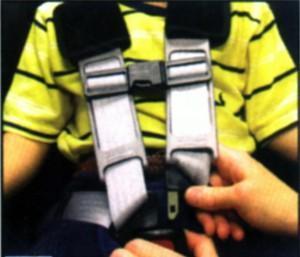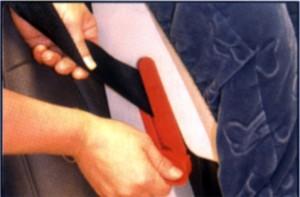ASK THE VEHICLE SAFETY LAWYER – Growing out of the Child Seat
This question has been hotly debated for years because parents and caregivers were given conflicting information. Some people said age was the determining factor. Others said height. Still, others said weight. THE CORRECT ANSWER IS WEIGHT.
Table of Contents
ToggleGrowing Out of the Child Seat
This is according to the American Medical Association (AMA).
There are four kinds of seat belt systems that children will use from the time they begin riding in vehicles until the time they pass away, hopefully as a senior citizen.
A child must use a rear facing child seat from BIRTH UP THROUGH AGE ONE AND 20 POUNDS. Only after age one and 20 lbs. should a rear facing child seat be turned around, so that, it is now forward facing. The AMA has said that children are safer in rear facing child seats than in any other configuration. In Sweden, it is not uncommon for children to be two or three years old and still be in rear facing child seats.
According to the AMA, a child can use a forward facing child seat from 20 lbs up to 40 lbs. However, it is my personal belief that a child should stay in a forward facing child seat up through 60 lbs. I differ with the AMA because I focus on the effectiveness of safety systems in the event of an accident. I believe that a child under 60 lbs. simply cannot handle the accident forces.
 I am a firm believer in keeping children encased inside the protective confines of a 5-point seat belt system. If a 5-point seat belt system is good enough to protect race car drivers, pilots and astronauts, then I want my child using this type of safety system as long as I can force them to use it.
I am a firm believer in keeping children encased inside the protective confines of a 5-point seat belt system. If a 5-point seat belt system is good enough to protect race car drivers, pilots and astronauts, then I want my child using this type of safety system as long as I can force them to use it.
Once a child is over 40 lbs. according to the AMA, then a child can use what is commonly referred to as a belt positioning booster seat. Now, again, I endorse that a belt positioning booster only be used by children over 60 lbs. Here is why. A belt positioning booster typically has no straps that are attached to the booster seat. The child is actually sitting on a seat whose sole purpose is to raise the child’s buttocks up so that the adult seat belt inside the vehicle will now fit properly across the child. I BELIEVE THIS TYPE OF BOOSTER SEAT DESIGN IS MUCH LESS SAFER THAN A BOOSTER SEAT THAT HAS A 5-POINT DESIGN AND IS ATTACHED TO THE VEHICLE. When the type of booster seat that is not attached to the seat is used, it is critically important that the parent or caregiver make certain that the child knows to pull the vehicle seat belt all the way out each time the booster seat is buckled into place so that the ALR locking feature is engaged. Parents will know when this occurs because the seat belt cannot be pulled out once the ALR feature is engaged. The child then needs to tighten the adult seat belt as much as they can.
When a child turns 80 lbs., then the parent or caregiver needs to evaluate if a child is ready to sit in the rear of a vehicle using only the vehicle seat belt. REMEMBER, EACH VEHICLE REAR SEATING CONFIGURATION IS DIFFERENT. A CHILD MAY FIT PERFECTLY IN ONE VEHICLE, AND STILL NEED A BOOSTER SEAT IN ANOTHER. Here are some guidelines to use when deciding if your child is ready to use only the vehicle seat belt.
Growing Out Of The Child Seat
 First, put the vehicle seat belt on the child and see where the shoulder strap contacts the child. The shoulder strap should fit across the collarbone. It should not be off to the side of the shoulder or up against the neck, cheek or face. If the shoulder strap isn’t across the collarbone, use a booster seat. Look and see if the shoulder belt crosses over your child’s chest bone/sternum. If not, use a booster seat. Lastly, check and see if the lap belt routes across and below your child’s hip bones. If not, use a booster seat. A seat belt must be positioned across all the hard bony structures of the body in the event of an accident. These bony structures include the collarbone, /chest bone sternum and hip bones. If a seat belt isn’t properly positioned on the hard bony structures, then the child can suffer serious internal organ injuries, spinal fractures or brain injury when the blood supply is cut off due to shoulder belt routing next to the vessels in the neck.
First, put the vehicle seat belt on the child and see where the shoulder strap contacts the child. The shoulder strap should fit across the collarbone. It should not be off to the side of the shoulder or up against the neck, cheek or face. If the shoulder strap isn’t across the collarbone, use a booster seat. Look and see if the shoulder belt crosses over your child’s chest bone/sternum. If not, use a booster seat. Lastly, check and see if the lap belt routes across and below your child’s hip bones. If not, use a booster seat. A seat belt must be positioned across all the hard bony structures of the body in the event of an accident. These bony structures include the collarbone, /chest bone sternum and hip bones. If a seat belt isn’t properly positioned on the hard bony structures, then the child can suffer serious internal organ injuries, spinal fractures or brain injury when the blood supply is cut off due to shoulder belt routing next to the vessels in the neck.
Second, you must now check and see how much space is between your child’s hip and the seat belt buckle. If there is more than 6 inches, you need to use a booster seat. A large gap allows the child’s buttocks to slide under the lap belt which is called submarining. When a child submarines under the lap belt, internal organ and spinal fractures occur.
Third, REMEMBER THAT THE REAR SEATS IN VEHICLES AREN’T ALL ALIKE. Take the time to evaluate your vehicle with your child. Explain to them what you are doing and why you are doing it. As I say to my children, I’d rather be safe than sorry or I’d rather you be mad now rather than you spend a lifetime in a wheelchair. Evaluate any vehicle that the child will be riding in.
Fourth, keep a booster seat handy for those occasions when your child goes home with a friend or a relative and the rear seat belt doesn’t properly fit your child.
For more than two decades, The Tracy Firm has been helping to assert the rights of individuals injured in vehicle accidents due to manufacturing design defect, safety system failures, vehicle aggressiveness and vehicle crashworthiness throughout the United States.
Contact us online, or, call us today at 214-324-9000 if you or your loved ones are seriously injured in an accident.

